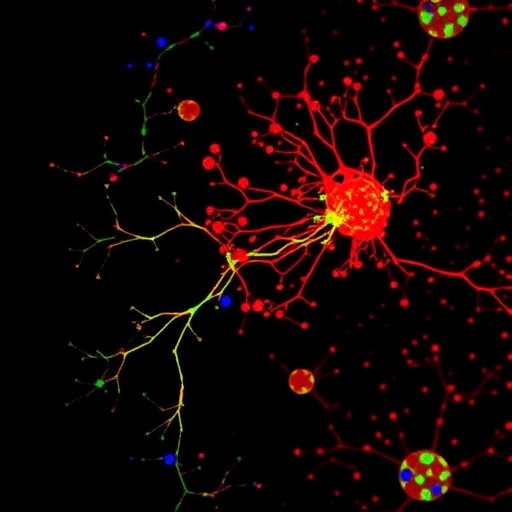A groundbreaking development in cancer therapeutics has emerged from the collaborative efforts of Georgia State University researchers and the biotech startup Da Zen Theranostics. Their innovative treatment, known as DZ-002, has recently advanced into Phase 2 clinical trials, marking a significant milestone in the ongoing battle against cancer. This novel therapy employs a targeted radiation mechanism designed to selectively destroy tumor cells with a precision that minimizes collateral damage to healthy tissues, potentially revolutionizing oncological treatment paradigms and providing renewed hope for patients with limited treatment options.
The core of DZ-002’s therapeutic strategy hinges on a unique fluorescent dye-drug conjugate developed to exploit the molecular signatures of cancer cells. This conjugate originates from the diagnostic innovation MHI-148, a compound designed by Professor Maged Henary, a prominent chemist and associate chair of the Department of Chemistry at Georgia State University. MHI-148 exhibits tumor-targeting capabilities by fluorescing upon binding to cancer cell membranes, thereby enabling enhanced visualization during imaging procedures and surgical interventions. This dual functionality—diagnostic fluorescence combined with therapeutic drug delivery—is pivotal in increasing the selectivity and efficacy of cancer treatments while reducing systemic toxicity.
The molecular architecture of MHI-148 facilitates its role as both a contrast agent and a vehicle for targeted drug delivery. By selectively accumulating within cancerous tissues, the dye component not only illuminates tumors for improved detection but also provides a binding platform for the conjugated chemotherapeutic agents. This selective binding is mediated by the dye’s affinity for transport proteins and cellular components uniquely overexpressed in malignancies, particularly in solid tumors and lymphoma. As a result, this technology bridges the gap between tumor identification and precise drug delivery, overcoming a longstanding challenge in oncology where therapeutic agents often impact both cancerous and normal cells indiscriminately.
Da Zen Theranostics, under the leadership of CEO Yu-Ping Cheng, is spearheading the transition of DZ-002 from preclinical development into rigorous clinical evaluation. The current Phase 2 trials are specifically focused on pancreatic cancer, a disease notorious for its poor prognosis and resistance to conventional therapies. Pancreatic tumors present significant clinical challenges due to their aggressive nature, dense stromal environment, and limited responsiveness to chemotherapy and radiotherapy. DZ-002’s radiant approach, utilizing its dye-mediated selective uptake and localized radiation, aims to extend remission periods and enhance the quality of life for patients with late-stage disease who currently face few treatment options.
The therapeutic mechanism underpinning DZ-002 involves the emission of targeted radiation from within the tumor microenvironment. Upon accumulation of the dye-drug conjugate in cancer cells, localized radiation is delivered directly to malignant tissue, causing lethal DNA damage and tumor cell apoptosis. Crucially, this method restricts radiation exposure to the tumor locale, mitigating the adverse effects associated with traditional external beam radiotherapy. The precise control afforded by DZ-002 biology also suggests potential for combinational regimens, whereby it may be synergistically paired with immunotherapies or other cytotoxic agents to amplify anti-tumor efficacy.
Professor Henary highlights the extensive research trajectory leading to DZ-002’s current status, emphasizing that the development process entailed over 14 years of meticulous chemical synthesis, in vitro and in vivo biological assays, as well as regulatory and patent preparations. Such a comprehensive research foundation ensures that the pharmacokinetics, biodistribution, and safety profile of the compound have been thoroughly characterized, fostering confidence as the treatment progresses through clinical phases. The convergence of chemistry, molecular biology, and translational medicine embodied by this project exemplifies the multidisciplinary approach necessary for next-generation cancer therapeutics.
Critical to the innovation is the compound’s capability to selectively differentiate cancer cells from healthy tissues based on their unique molecular environment. Tumor cells often exhibit altered metabolic pathways and membrane transporter expressions, characteristics exploited by the fluorescent dye to achieve high specificity. This selective affinity not only enhances the accuracy of tumor delineation during surgical resection but also ensures that the cytotoxic payload is delivered preferentially, thus reducing systemic side effects commonly observed in conventional chemotherapy regimens.
The initiation of Phase 2 clinical trials at the HOAG Cancer Center denotes a significant advancement in the translational pipeline. These trials will primarily evaluate the safety, dosage parameters, and therapeutic efficacy of DZ-002 in a controlled patient cohort with pancreatic cancer. Success at this stage is vital, as it would validate DZ-002’s potential for broader clinical application and advance it closer to potential regulatory approval. Moreover, ongoing trials provide critical opportunities to understand patient responses, optimize treatment protocols, and investigate biomarkers predictive of therapeutic outcomes.
In addition to its clinical promise, DZ-002 represents a platform technology with the versatility to be adapted for other solid tumors and hematological malignancies. Its unique integration of diagnostic imaging with targeted therapy propels it beyond the scope of traditional chemotherapeutics, suggesting future applications in personalized medicine where treatments are tailored based on individual tumor biology. This innovation may pave the way for developing multifunctional agents capable of simultaneous diagnosis, monitoring, and treatment, streamlining patient care and enhancing therapeutic precision.
Joanne Mitchell, director of Georgia State University’s Panther Innovations technology transfer office, underscores the broader significance of DZ-002’s progress. The successful translation of such university-originated innovations into mid-stage clinical trials exemplifies the critical role academic-industry partnerships play in accelerating novel treatments to the bedside. As a growing number of university-developed drugs enter clinical testing, platforms like Panther Innovations will be paramount in facilitating the commercialization and clinical integration of cutting-edge biomedical technologies.
The potential impact of DZ-002 transcends its immediate clinical applications. By markedly improving the specificity and efficacy of cancer treatments, it holds the promise to fundamentally alter survival trajectories and quality of life for patients afflicted with some of the most intractable cancers. Beyond pancreatic cancer, ongoing research and clinical exploration will determine the breadth of its applicability, potentially offering a new standard of care that merges molecular diagnostics with precise therapeutics in the fight against cancer.
In conclusion, DZ-002 represents a beacon of innovation and hope in oncology. Rooted in years of rigorous scientific inquiry and propelled by a synergistic academic and biotech collaboration, this treatment could herald a new era for cancer patients worldwide. The commencement of Phase 2 trials is both a vital step in clinical validation and a testament to the unwavering commitment of researchers and clinicians dedicated to transforming cancer treatment and patient outcomes.
Subject of Research: Targeted cancer therapy using fluorescent dye-drug conjugates for precision tumor imaging and treatment.
Article Title: Breakthrough Cancer Therapy DZ-002 Advances into Phase 2 Trials, Offering Hope for Pancreatic Cancer Patients.
News Publication Date: Information not provided.
Web References:
https://cas.gsu.edu/profile/maged-henary/
https://www.dazenthera.com/
https://research.gsu.edu/georgia-state-technology-transfer/
https://news.gsu.edu/research-magazine/the-end-of-a-long-pipeline-cancer-treatment-maged-henary
https://www.hoag.org/
http://research.gsu.edu/
Image Credits: Courtesy: Georgia State University
Keywords: Clinical trials, Cancer immunotherapy, Targeted cancer therapy, Fluorescent dye-drug conjugate, Pancreatic cancer, Molecular imaging, Precision oncology.
Tags: cancer therapy advancementsDa Zen Theranostics collaborationdual-functionality in cancer treatmentDZ-002 treatmentfluorescent dye-drug conjugateGeorgia State University researchMHI-148 compoundoncological treatment innovationsPhase 2 clinical trialssystemic toxicity reductiontargeted radiation therapytumor-targeting capabilities





